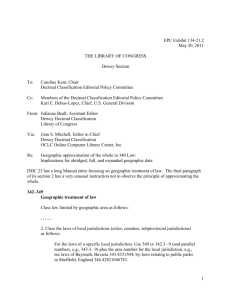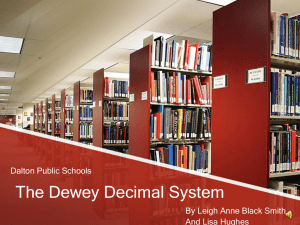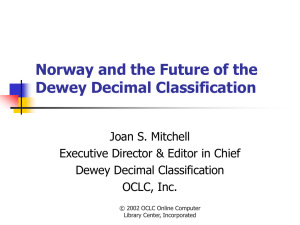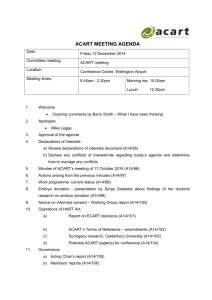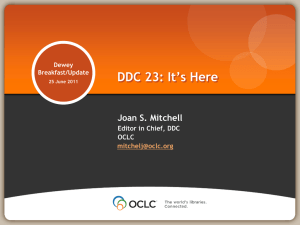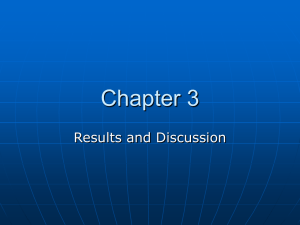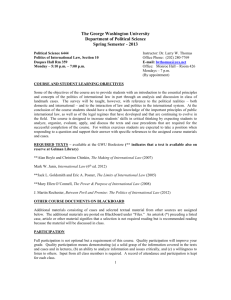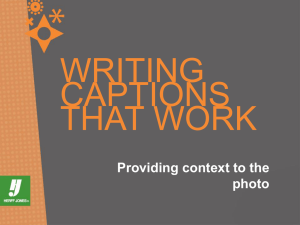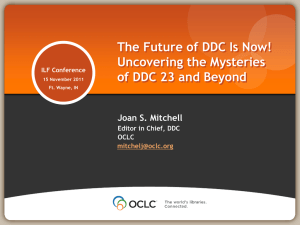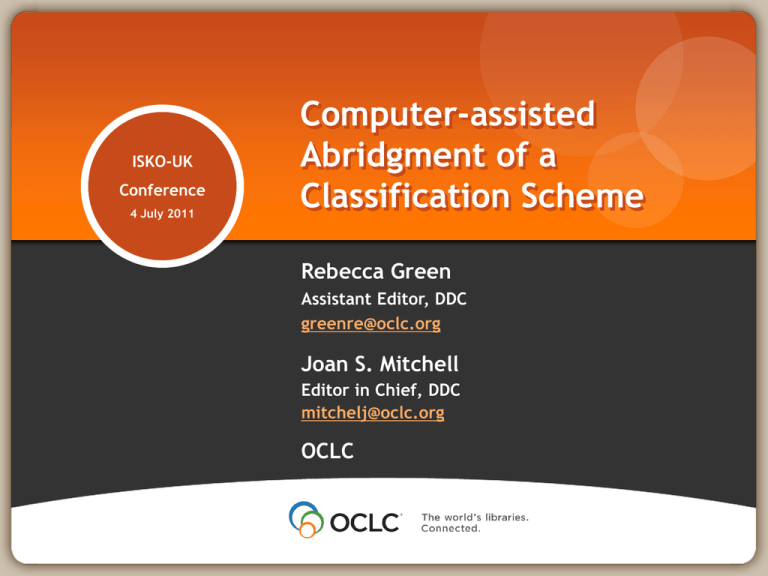
ISKO-UK
Conference
4 July 2011
Computer-assisted
Abridgment of a
Classification Scheme
Rebecca Green
Assistant Editor, DDC
greenre@oclc.org
Joan S. Mitchell
Editor in Chief, DDC
mitchelj@oclc.org
OCLC
Motivations (1)
• Inform derivation of different views of the DDC, for
example:
• Translations of abridged English-language edition with
expansions in targeted areas
• Translations of full English-language edition with abridgments
in targeted areas
• DDC mixed translation model (classes in vernacular at
abridged level of notation combined with full Englishlanguage edition classes at subordinate levels)
Motivations (2)
• Reduce costliness of current process of intellectual
logical abridgment (for Dewey editorial team and
translators)
• Year-long effort to produce abridged edition “by hand”
• Several-months-long effort to produce abridged edition
with computer-assisted process
• Use abridgment process as quality control measure for
full English-language edition
Abridgment guidelines
• Abridged edition is logical abridgment of full edition
• Abridged edition derived from full edition based on set of
rules with minimal intellectual intervention
• Classes in current abridged edition (A14) as starting point
for notational framework
• Classes initially populated with data from corresponding
A14 (abridged-specific data only), new full Englishlanguage edition (DDC 23) classes
• Further action needed for several kinds of notes
Including notes: Contents
• Topics in full edition including note
• Captions from subordinate classes one level down
• Topics in class-here notes from subordinate classes one
level down
• If caption is “node label,” captions from subordinate
classes appear as examples
Including notes: Refinements
• Topics from subordinate classes skipped if:
• Standard subdivisions
• Wholly represented in the A14 caption
• (Table 2) Represented in A14 caption after
directional vocabulary (e.g., east, northwestern)
and administrative units (e.g., state, province)
deleted
Including notes: Example 1a
004.2 Systems analysis and design, computer architecture,
performance evaluation
Including analysis of a user’s problem preparatory to
developing a computer system to solve it; performance
measurement and evaluation to aid in designing or
improving the performance of a computer system;
systems analysis and design, computer architecture,
performance evaluation of specific types of electronic
computers
• A14 notational framework includes 004.2, not 004.21—004.25
Including notes: Example 1b
004.2 Systems analysis and design, computer architecture,
performance evaluation
Including analysis of a user’s problem preparatory to
developing a computer system to solve it; performance
measurement and evaluation to aid in designing or
improving the performance of a computer system;
systems analysis and design, computer architecture,
performance evaluation of specific types of electronic
computers
• A14 notational framework includes 004.2, not 004.21—004.25
• Captions from 004.21, 004.22, 004.24 already included / skipped
Including notes: Example 1c
004.2 Systems analysis and design, computer architecture,
performance evaluation
Including analysis of a user’s problem preparatory to
developing a computer system to solve it; performance
measurement and evaluation to aid in designing or
improving the performance of a computer system;
systems analysis and design, computer architecture,
performance evaluation of specific types of electronic
computers
• A14 notational framework includes 004.2, not 004.21—004.25
• Captions from 004.21, 004.22, 004.24 already included / skipped
• Topics from class-here notes one level down (004.21, 004.24)
Including notes: Example 1d
004.2 Systems analysis and design, computer architecture,
performance evaluation
Including analysis of a user’s problem preparatory to
developing a computer system to solve it; performance
measurement and evaluation to aid in designing or
improving the performance of a computer system;
systems analysis and design, computer architecture,
performance evaluation of specific types of electronic
computers
•
•
•
•
A14 notational framework includes 004.2, not 004.21—004.25
Captions from 004.21, 004.22, 004.24 already included / skipped
Topics from class-here notes one level down (004.21, 004.24)
Caption from subordinate class one level down (004.25)
Including notes: Node labels
• Operational definition
• Class has no Relative Index terms assigned
• Two or more subclasses have Relative Index terms assigned
• Action
• Gather captions from one level down
• Apply duplication and standard subdivision restrictions
• Insert as parenthetical “e.g.” after node label caption
Including notes: Example 2
155.6 Psychology of adults
Including adults by gender or sex; adults by
marital status and relationships (e.g., single
status, separated and divorced status, widowed
status, married status, parents, grandparents,
progeny, siblings); people in early adulthood;
comprehensive works on young adults; people in
middle adulthood
• Node label at 155.64; e.g. clause drawn from captions at
155.642, 155.643, 155.644, 155.645, 155.646
Including notes: Example 3
2—425 East Midlands of England
Including *Chiltern Hills, *Trent River; Derbyshire and Derby
City; *Derwent River of Derbyshire; Nottinghamshire and
Nottingham City; Lincolnshire; *Lincoln Heath; *the Wash;
*Witham River; Leicestershire, Leicester City, Rutland
County; Northamptonshire; *Nene River; Bedfordshire and
Luton Borough; Oxfordshire; Hertfordshire; Buckinghamshire
and Milton Keynes
*For a specific part of this jurisdiction, region, or feature, see
the part and follow instructions under —4-9
Abridgment of numbers in notes
• Simple class number
• Is number in abridged notational framework?
• Does number in full edition give segmentation?
• Does number include a standard subdivision from Table 1?
• Is number without Table 1 notation in abridged?
• If so, find abridged standard subdivision
• Complications
• Spans
• Internal add tables
• Numbers built following add instructions
Class-elsewhere notes; see references
• DDC 23 notes at same notational level and all levels down
• Reordered logically (direct/scatter;
comprehensive/interdisciplinary)
• If abridged number in upward hierarchy of number where
note found, see reference converted into class-elsewhere
note
See references: Example 1
302.2 Communication
For information theory, see 003.54; for religious
symbolism, see 203.7; for Christian religious
symbols, see 246.55; for conversation, see
302.346; for censorship, see 303.376; for
language, see 400; for iconography, see 704.9;
for insignia, see 929.9. For the semiotics of a
specific subject, see the subject, plus notation
014 from Table 1, e.g., semiotics of biology
570.14; for symbols in a specific subject other
than religion, see the subject, plus notation 0148
from Table 1, e.g., symbols in electrical
engineering 621.30148
See references: Example 2
004.16
Personal computers
...
For midrange computers, see 004.1
converted to:
004.16
Personal computers
...
Class midrange computers in 004.1
Auto-abridgement process: Dependencies
• Expressive notation
• Distinction between topics that approximate the whole of
a class and topics in standing room
• Well-defined inventory of notes
Auto-abridgement process: Implications
• Development and maintenance of the DDC
• Discovery of structural inconsistencies in the DDC
• Derivations of different views of the DDC

